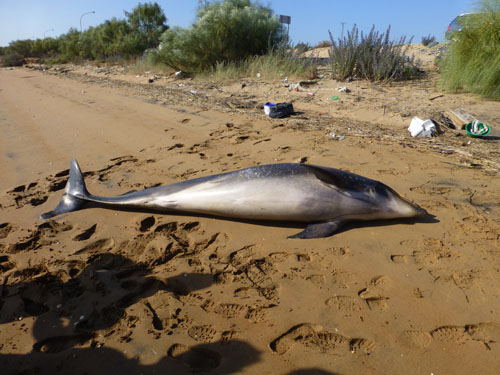A study by the CSIC, CIRCE, the University of Hohenheim, CREMA and CEGMA, has demonstrated that flame retardant pollutants, the classical ones, PBDEs, and the new substitutes, are able to cross the blood-brain barrier and penetrate the brain of cetaceans.
 Flame retardant pollutants can surpass the blood-brain barrier and reach the brain, as Spanish and German scientists confirm in a new study which is published in the magazine Environmental Science and Technology.
Flame retardant pollutants can surpass the blood-brain barrier and reach the brain, as Spanish and German scientists confirm in a new study which is published in the magazine Environmental Science and Technology.
This study, led by Ethel Eljarrat, a scientist at the Instituto de Diagnóstico Ambiental y Estudios del Agua (IDAEA-CSIC), has analyzed biological samples from 26 dolphins of five different species: the common dolphin (Delphinus delphis), the striped dolphin (Stenella coureloalba), the long-finned pilot whale (Globicephala melas), the Risso’s dolphin (Grampus griseus) and the bottlenose dolphin (Tursiops truncatus), from the Alboran Sea, at the South of Spain.
The team has analyzed the conventional flame retardants (PBDEs), which are now forbidden, and their substitutes, the so called emerging flame retardants. Also, other natural brominated molecules which have a similar structure but are naturally generated by organisms such as algae and sponges, have been analyzed.
The most striking result is that all the analyzed compounds have been detected in the brain of the dolphins. “We have seen”, says Ethel Eljarrat, “that all these molecules are able to cross the blood brain barrier. Without this protective barrier, many harmful substances would enter the brain, therefore affecting its functions. And this is the case of the flame retardants analyzed in our work: they are crossing the blood-brain barrier”.
The result raises many questions. Why these compounds, both the pollutant flame retardants and the natural molecules with similar structure, can surpass the blood-brain barrier? Do they have neurological effects? Is the same thing happening with humans?
As the work shows, levels of the different pollutants in the samples differ depending on their capacity to penetrate the brain. The highest levels have been found for the new flame retardant compounds, which replace the forbidden PBDE. That would demonstrate that they have more capacity to cross the blood-brain barrier. It is followed by the classical flame retardants PBDEs, and by the natural molecules produced by algae and sponges, with the lowest concentrations. “This means that it is necessary to carry out new studies to assess the potential neurological effects of these compounds. It might happen that the new flame retardants are even more harmful than the previous PBDE”, says Ethel Eljarrat.
This study has been possible thanks to the recovery of dead stranded dolphins on the Andalusian beaches, and the extraction of their brain by the vets and biologists. “The accessibility of a tissue bank of cetaceans in Andalucia has made this work possible and opens up the possibility of developing new studies focused on other types of pollutants. On the other hand, the maintenance and enlargement of these tissue banks is essential to finding out the health status of cetaceans”, says Dr. de Stephanis, from CIRCE (Conservation, Information and Research on Cetaceans).
Flame retardants are compounds widely used in the industry. They are added to all kinds of goods, such as clothing, electronics devices, furniture and broad tapestry, in order to reduce the risk of fire. It has been demonstrated that they remain for a long time in the environment, accumulate in the organism and may have toxic effects on wildlife and humans.
This study is part of the doctoral thesis on environmental impact of new flame retardants that the young scientist, Enrique Barón, is developing at the IDAEA. The study is led by the Instituto de Diagnóstico Ambiental y Estudios del Agua (IDAEA-CSIC). Other institutions have been involved: the Doñana Biological Station (EBD-CSIC), and CIRCE (Conservation Information and Research on Cetaceans), the Centre for the recovery of Threatened Marine Species (CREMA), the Centro de Gestión del Medio Marino Andaluz (CEGMA) of the local Andalusian government, and the University of Hohenheim (Germany). It is funded by the projects FLAME, ECOCET and Consolider SCARCE, and has been supported by the Loro Parque Fundación, CEPSA and the former Spanish Ministry of Science and Innovation.
Reference article:
Halogenated Natural Products in Dolphins: Brain–Blubber Distribution and Comparison with Halogenated Flame Retardants. E.Barón et al. Environ. Sci. Technol., Article ASAP DOI: 10.1021/acs.est.5b02736
